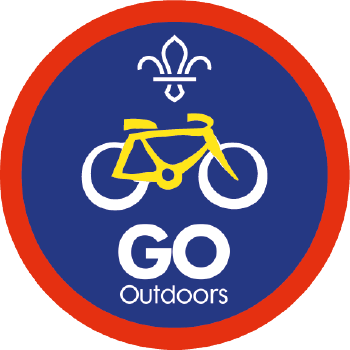
Incident bike
You’ll need
- Bikes
- PPE, including helmets and pads
- Equipment for checkpoints
Before you begin
- Use the safety checklist to help you plan and risk assess your activity. Additional help to carry out your risk assessment, including examples can be found here. Don’t forget to make sure all young people and adults involved in the activity know how to take part safely.
- If you would prefer to run this activity on foot, check out our activity ‘Incident hike’ instead
- Decide on the challenges and checkpoints before you begin. We have included some suggestions below. Make sure you have enough leaders to be placed at each checkpoint along the route.
- Make sure you read our guidance on cycling activities before you begin.
- Organise the trip well in advance. Plan a circular route around your local area, ideally off-road or on designated cycle paths. Make sure any checkpoints are safe places for groups to stop.
- Don’t forget to test the route for hazards and do a risk assessment before your ride.
- Invite parents and carers who cycle to come along and help.
- Make sure that everyone taking part has access to a bike. Anyone who doesn’t have one could borrow one – some people may have spare bikes that belong to siblings, or bikes their children have outgrown, that they’re happy to lend. There will probably be a mix of people with and without stabilisers, or they might find a balance bike easier or quicker to ride.
- Everyone should bring a refillable water bottle (and snacks, if you’re planning a longer ride).
Be prepared!
- Everyone should split into small teams (around 4-6 people) and receive their map.
This should be marked with their checkpoints that they need to reach. You may choose to draw the route in advance for them. Alternatively, let your young people decide their route between each checkpoint. Cyclists are allowed to ride (in England and Wales) on roads, byways, bridle paths and other higher classified tracks. They can also ride where the landowner has given their permission, e.g. much Forestry Commission land. In Scotland the access is much wider with responsible access being used. - Make sure everyone has the appropriate protection equipment before setting off. Each group should have a leader or adult accompanying them. Helmets must be worn by all.
- Remind everyone to be respectful of their surroundings and to stick to designated paths to help protect the area around them.
Challenges to put along the route
Present this riddle and ask the group to solve it. You could even give each of them a role and ask them to act out the solution. If someone has already done this before, consider asking them to sit out to let the rest of the team solve it.
A Scout is returning from the market, where they bought a chicken, some wheat and a fox. They only have enough space in their bike’s basket to carry one thing at a time. They cannot leave the chicken alone with the wheat because the chicken would eat it. They cannot leave the chicken alone with the fox or the chick will get eaten. How will the Scout get everything home from market?
Solution
Take the chicken to the other side. Go back, take the wheat, unload it on the other side where you load the chicken, go back and unload it. Take the fox to the other side where you unload it. Go back for the chicken.
You will need
- Stopwatch or phone
- Cones or markers
Follow this activity to see in more detail how to run a cycle slalom.
You will need:
- Stopwatch or phone
- Bike pump
- Winter lubricant
- Summer lubricant
- Full water bottles or hydration packs
- Small first aid kit
- Puncture repair kit
- Mudguards
- Waterproof grease
- Gloves
- Hi-vis jackets and other reflective clothing
- Weather-appropriate clothing/accessories (like sunglasses, waterproofs or woolly hats)
Have all the kits laid out away from where the group has parked their bikes up. You may want to go through what each piece of equipment is and how to use it if the following challenge is too difficult. Give the group a scenario and ask them to run to the equipment and back again one at a time until they have all the appropriate equipment to deal with the scenario.
Scenario 1: you have a puncture on your tyre. You will need the bike pump and puncture repair kit.
Scenario 2: you’re cycling in cold weather. You will need winter lubricant, woolly hat and gloves, waterproof and reflective clothing. Bonus if they know to reduce the tyre pressure on their wheels.
Scenario 3: you’re cycling in wet weather. You will need the waterproof, reflective clothing, mudguards and waterproof grease.
Scenario 4: you’re cycling in hot weather. You will need the sunglasses, reflective clothing, water bottle and summer lubricant. Bonus is they know to increase the type pressure on their bike.
See the activities responsive riders and Cycling through the seasons for more detailed guidance on running this activity.
You will need
- Hi-vis items
- Reflective clothing
Hide the items around your checkpoint. Time the group to find all the items as quickly as possible. You may want to give them a torch/allow them to use phone torches to help them locate the items.
See the activity Hi-vis hustle for more detailed guidance on running this activity.
You will need
- First aid kit
This is a role-play first aid scenario. Either the leader, or a young person from the group participating can play as the casualty. The group should find someone who has fallen off their bike and is unresponsive. Encourage them to run through DR ABC to assess what to do in the situation.
See this activity Be an emergency aider: primary survey for more detailed guidance.
Reflection
This activity required you to work as a team to try to beat the challenges at the checkpoints. How did you work together during the cycle between checkpoints? Did you travel at a pace that worked for everyone? How did you communicate? Did you enjoy working as a team during the challenges?
You also worked on your navigation skills to make sure you stuck to the right route. Did you find navigating challenging? Did you discover new routes or places that you hadn’t noticed before?
Safety
All activities must be safely managed. You must complete a thorough risk assessment and take appropriate steps to reduce risk. Use the safety checklist to help you plan and risk assess your activity. Always get approval for the activity, and have suitable supervision and an InTouch process.
- Adventure
This activity has specific rules and systems to make sure it’s managed safely. Take a look at adventure activities for more guidance.
- Cycle and wheeled activities
Use appropriate protective equipment. You must wear helmets. Wear elbow and knee pads as defined by your risk assessment.
- Road safety
Manage groups carefully when near or on roads. Consider adult supervision and additional equipment (such as lights and high visibility clothing) in your risk assessment.
- Visits away from your meeting place
Complete a thorough risk assessment and include hazards, such as roads, woodland, plants, animals, and bodies of water (for example, rivers, ponds, lakes, and seas). You’ll probably need more adult helpers than usual. Your risk assessment should include how many adults you need. The young people to adult ratios are a minimum requirement. When you do your risk assessment, you might decide that you need more adults than the ratio specifies. Think about extra equipment that you may need to take with you, such as high visibility clothing, a first aid kit, water, and waterproofs. Throughout the activity, watch out for changes in the weather and do regular headcounts.
- Active games
The game area should be free of hazards. Explain the rules of the game clearly and have a clear way to communicate that the game must stop when needed. Take a look at our guidance on running active games safely.
- Outdoor activities
You must have permission to use the location. Always check the weather forecast, and inform parents and carers of any change in venue.
You can make the bike ride whatever length you like. If it’s a longer ride, you could even stop halfway for a picnic! Make sure everyone has somewhere to go to the toilet and wash their hands if it’s a longer bike ride.
Check that everyone can ride a bike – it’s OK if people use stabilisers.
Some disabled people may use a specially adapted bike, or ride in a bike trailer. You may be able to hire a suitable adapted bike from a local bike shop or cycle club. For more information, check out British Cycling disability hubs or Wheels for All locations page
Make sure the challenges are accessible and inclusive for your group.
All Scout activities should be inclusive and accessible.
Speak to young leaders and consider asking them to plan and run the checkpoints with challenges of their choosing.
